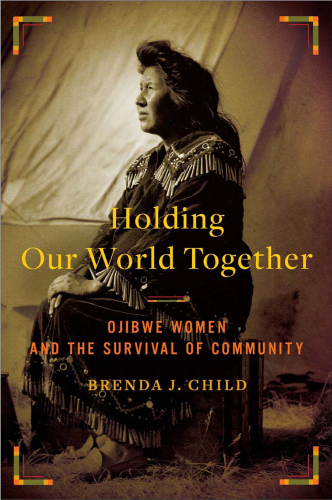
Holding Our World Together
Ojibwe Women and the Survival of the Community
کتاب های مرتبط
- اطلاعات
- نقد و بررسی
- دیدگاه کاربران
نقد و بررسی

December 12, 2011
Dismissed by early American and European historians, Native American women have long taken a backseat to chiefs, warriors, and huntsmen. In this broad historical account, Child (Boarding School Seasons: American Indian Families: 1900–1940) sheds light on the role of women as linchpins of the Ojibwe world: forging kinship ties and strategic alliances; maintaining medicinal knowledge; organizing the seasonal harvests; participating in civil rights groups like the American Indian Movement; and bolstering community values as social activist leaders. From the strategic alliances of the fur-trading days to the forced “civilization” of the reservation era, Child follows the ups and downs of white relations with the tribes and shows how women held communities together as removal policies and land theft disrupted the harmonious seasonal round of berry picking, wild rice harvesting, and maple sugar collecting in the Great Lakes region. Instead of despairing at the racism and deprivation they faced, these resourceful women adapted to a new tourist and service economy while preserving the traditions and family bonds that enrich Ojibwe life. Though some documented anecdotes and myths could have used more room to breathe, the book offers a sensitive portrait of a resilient group and the struggles it has overcome.

December 15, 2011
In a follow-up to her prize-winning study, Boarding School Seasons: American Indian Families: 1900-1940 (2000), Child (American Studies/Univ. of Minnesota) chronicles the "history of Ojibwe community life in the Great Lakes," with special emphasis on the role of women. As a member of the Red Lake Ojibwe Nation, the author has an intimate connection to her subject. Beginning in the 1830s, with the U.S. government's policy of forced relocation of Native Americans to reservations, Child chronicles the destruction of their way of life, which had been based on the cultivation of wild rice, traditionally woman's work, and hunting, which was done by men and boys. When the Ojibwe were forcibly removed from their homes and land in Michigan and Wisconsin to a reservation in the territory of Minnesota, their standard of living was reduced to bare subsistence. Forced to depend on food shipments and a meager annuity from the government, their population was decimated by starvation and disease. Remarkably, they preserved the core of their cultural beliefs, and traditional spiritual values survived despite the pressures and hardships of their new circumstances. The author writes of the unsuccessful but relentless drive of the institutions of the dominant American population to impose its core values, such as the inferior position of women in society and the replacement of traditional religious practices with Christianity. In some ways, the situation of the Ojibwe improved during the New Deal when the policy of forced assimilation ended. Poverty-relief programs run by New Deal agencies offered new employment opportunities, and the Ojibwe received funding to farm wild rice using modern methods. During World War II, Indian men were subject to the draft while women worked in defense plants. Today the vast majority live in cities while maintaining ties to the reservation and their traditional way of life. A fascinating account of a resilient culture that has survived despite oppression.
(COPYRIGHT (2011) KIRKUS REVIEWS/NIELSEN BUSINESS MEDIA, INC. ALL RIGHTS RESERVED.)

January 1, 2012
In this latest volume in the Penguin Library of American Indian History, Child addresses the unique role women have played in the community life of her nation, the Red Lake Ojibwe Nation of northern Minnesota. She begins with a history of Ojibwe culture in the Great Lakes area since the late eighteenth-century, when women served as intermediaries with the European newcomers, especially fur traders. In the reservation era, women were called on to hold things together, as the move to reservations disrupted the politics and resources of the Ojibwe people, forcing them to make difficult decisions as each treaty with the U.S. and Canada was signed. Child addresses the travesty of Indian boarding schools, focusing on the one started near Mount Pleasant, Michigan, in 1893 on sacred Ojibwe burial grounds. She concludes with the post-WWII Ojibwe migration to Minneapolis, where women quickly adopted leadership positions in activist groups. Child offers a penetrating look into how crucial Ojibwe women have been over the last two centuries in holding the Ojibwe Nation together against forces threatening to tear it apart.(Reprinted with permission of Booklist, copyright 2012, American Library Association.)

























دیدگاه کاربران